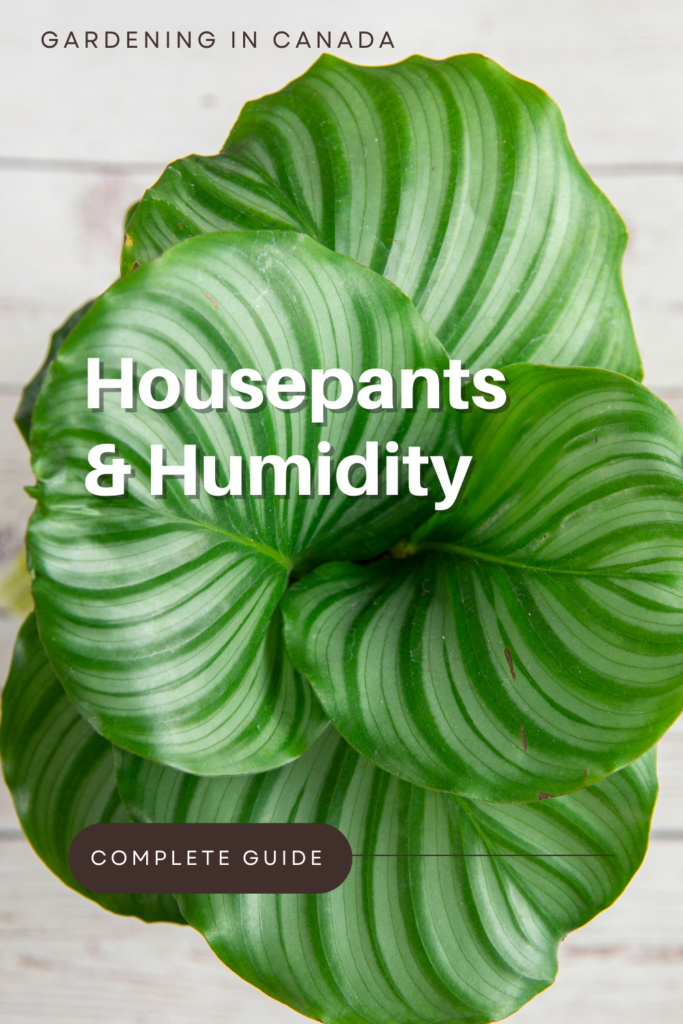- Canada’s Growing Zones Are Changing 2024 - January 12, 2024
- Attracting Wildlife To The Garden - May 16, 2023
- How To Garden Near A Septic Tank - May 9, 2023
The Complete Guide To Humidity and Houseplants
One of the most common questions I get asked about Houseplants is how do I tell if I have enough humidity. Exploring the relationship between humidity and houseplants is key. This gardening in Canada article is going to look at whether or not your house plants have enough humidity and give you a complete guide on the concept.
If you are new to this blog my name is Ashley and I am a soil scientist. I am located in a Canadian Zone 3 and a USDA Zone 4. I write articles, make YouTube videos, Instagram & Facebook posts all designed for Canadians and Cold Climate gardeners using science-based methods. If you are looking for anything specific be sure to let me know in the comments down below.
Signs Of Humidity Issues
A sign that your plant may not be getting enough humidity is crisp outer leaf edges. In particular we are looking at the edges of the leaves becoming crispy and brown. This is a sign of humidity loss or lack of humidity because it indicates collapsing cells.
Ambient humidity is used in the process of respiration. When the plant’s stomata opens up it allows for exchange of CO2 and water. If the air surrounding the leaf is particularly dry more water is lost through the leaves. This loss and moisture can cause the plant’s leaves to shrivel.
If the air is dry and too much water is lost through the plants stomata. We end up with less water in our plant system. It’s important to keep in mind that if the soil substrate also lacks soil moisture we can have the same result.
If you are seeing brown blotches on your leaves this is not a sign of moisture loss. This is likely a bacterial infection especially if these blotches are uniform and round. signs of moisture issues and Houseplants is only crisping of the edges.
Does The Pebble Dish Help With Houseplants And Humidity
This unfortunately is not going to help with the ambient humidity in your room. The only way a pebble dish would help increase the ambient humidity in a room is if the pebble dish was placed over a radiator. This will allow the moisture to be absorbed into the air.
The process of using an air vent for increasing ambient humidity in your home does not have to be a pebble dish in particular. You can consider using simply a plastic yoghurt cup or anything that holds water with an open top. Pie plates and disposable bread pans are some of my favourites.
Misting Your Plants For Humidity
Another popular method that is thought to increase the ambient humidity is misting. Again unfortunately this is not going to increase the ambient humidity within your homes air. There simply is just not enough moisture in a simple misting to get the desired effect.
While misting won’t harm your plant it is unlikely to make any drastic differences. The main objective here is to increase the ambient humidity in the air as a whole. Not just the humidity on the leaf surface.
Humidifier
The use of a humidifier is a great way to see results. When you use a humidifier in your home you are increasing the ambient humidity of your air. This means that when the plant goes to Respirer it is able to reduce its water loss. This means you are less likely to have browning tips on your leaves.
You can get large humidifiers that can do large spaces. I will list some of the humidifiers that I currently use down below. Each one does approximately 1000 ft.² and one of which has an area for essential oils.
These will drastically increase the ambient humidity of your home. This is the exact affect you’re looking for when it comes to plants.
Essential Oils Humidifier
VPD
If you wanna learn more about exactly what it means to have proper humidity for plans check out my article on vapour pressure deficits. This is an important article for anyone looking to achieve rapid growth with their house plants.
The concept is relatively simple. We know that plants work similar to a straw and if water is being expelled nutrients are being taken out. This is why we want our ambient humidity to be less than 100%.
We want some water loss through the stomata during respiration. this helps ensure that water is still being taken up along with the new trans solubilized within that water. VPD is a great way to know what your ambient humidity should be at based on your homes temperature.
The warmer your home is the higher the ambient humidity should be. The cold or your home is the lower her ambient humidity should be. If you’re room temperature is too low and your ambient humidity is too high you can end up with disease and fungal growth. You are also end up with stunted plant growth because the plant is not taking as much nutrients and water.
For more information on this concept be sure to check out the article and video I did.
One of the most common questions I get asked about Houseplants is how do I tell if I have enough humidity. This gardening in Canada article is going to look at whether or not your house plants have enough humidity and give you a complete guide on the concept.

